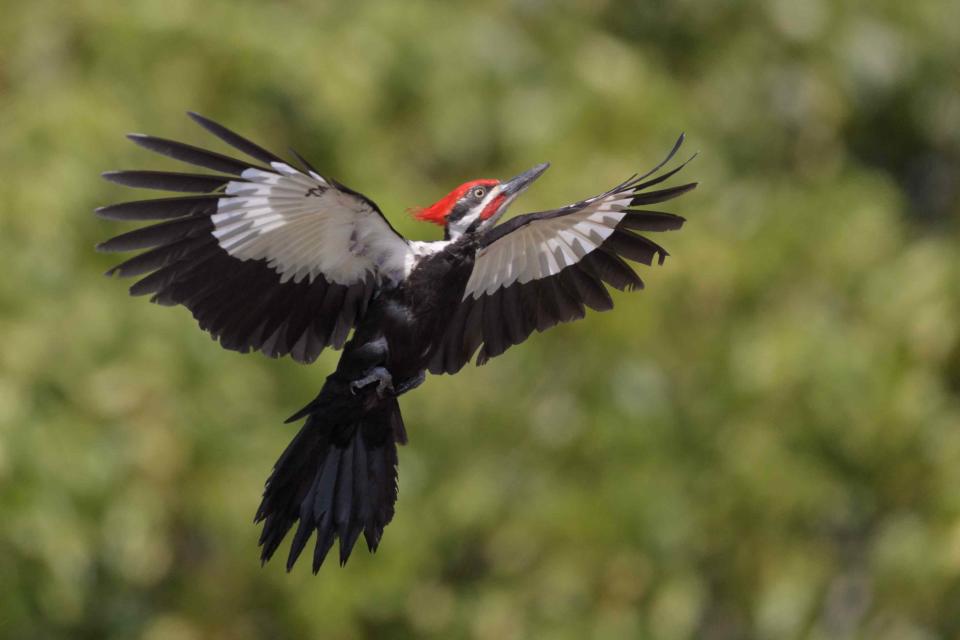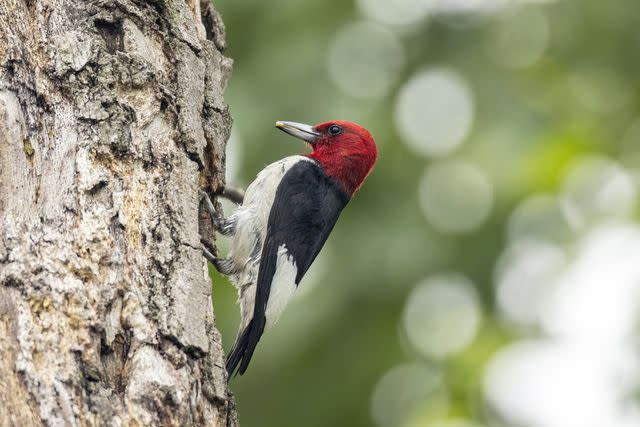How To Keep Woodpeckers Away, According To Experts
Here’s what to do if a woodpecker starts pecking on your house.

Getty Images / Carlos Carreno
You may hear the neighborhood woodpeckers at work when they’re dining on spiders, grubs, or insects such as ants in the nearest dead tree. But their loud hammering is impossible to miss if they start on your house.
“Woodpeckers pecking on your house may be searching for food, just as they would do on a hollow tree,” says Michael Mengak, PhD., certified wildlife biologist and professor at Warnell School of Forestry & Natural Resources at the University of Georgia. “This may indicate you may have an underlying pest issue, such as carpenter ants, carpenter bees, or termites.”
Woodpeckers also may find a knot hole in wood siding and think it looks like a great place to start excavating for a nest. Or they may hammer on your house, gutters, or downspouts to announce their presence.
“Woodpeckers use a rhythmic pecking, called drumming, to establish their territories,” says Robert Pierce, PhD, state extension fisheries and wildlife specialist at the University of Missouri. “Other birds use songs, but woodpeckers have specific pecking sequences to communicate or attract a mate, which is why drumming activity is highest in the spring.”
Meet The Expert
Michael Mengak, PhD., is a certified wildlife biologist and professor at Warnell School of Forestry & Natural Resources at the University of Georgia.
Robert Pierce, PhD, state extension fisheries and wildlife specialist at the University of Missouri.
Types of Woodpeckers
There are more than 45 woodpecker species in the U.S., ranging in size from 6 ½ to 20 inches tall. Some types migrate but many are year-round residents in the Southeast. Some of the most common types in the South include:
Downy woodpecker (Dryobates pubescens)
Hairy woodpecker (Dryobates villosus)
Red-headed woodpecker (Melanerpes erythrocephalus)
Red-bellied woodpecker (Melanerpes carolinus)
Pileated woodpecker (Dryocopus pileatus)
Northern flicker (Colaptes auratus)
Yellow-bellied sapsucker (Sphyrapicus varius)
Related: How To Get Rid Of Carpenter Ants, According To Experts
How To Identify Woodpecker Damage
Of course, if you hear or see a woodpecker rat-a-tat-tatting on the side of your house, shed, or deck, you know it’s the culprit. But you also may notice small round holes or rough vertical gashes an inch to several inches long on wood surfaces. It may be a small area, such as a high corner of the building, or it may be more extensive, says Pierce. Obviously, serious damage can be inflicted quickly by the larger species if they’ve discovered the presence of a carpenter ant nest, for example.

Getty Images/ Stan Tekiela Author / Naturalist / Wildlife Photographer
How To Keep Woodpeckers Away from Your House
Unfortunately, there’s no foolproof solution to keep these birds away from your house, but there are a few things you can do to discourage them, say Mengak and Pierce:
Be aware of what attracts woodpeckers: Wooded lots and wood-sided homes such as cedar shakes, board and batten, and log siding are especially appealing. While there’s nothing you can do about these factors, perform regular pest inspections to catch potential problems early, says Pierce.
Opt for lighter colors on wood siding. Interestingly, research indicates darker-colored homes (dark earth tones) have a higher incidence of woodpecker activity than brightly-colored homes (white, cream).
Inspect the area where a woodpecker is attracted to ensure you don’t have a hidden pest infestation, such as termites, says Mengak. If it’s in a spot you can’t reach safely, hire a pest control professional. Of course, deal with any infestation promptly.
Take action as soon as a woodpecker is becoming a nuisance with drumming behavior. “They’re very persistent and not easily driven from their territories. Once their behaviors are established, it’s difficult to break their habits,” says Pierce.
Hang bird netting to exclude birds from a favorite drumming site. Attach the netting to overhanging eaves and angle back to the area on the siding where the damage occurs, or drape it over stakes to keep them away from deck posts, says Mengak.
Use scare devices to discourage birds from visiting. The most effective methods are those that involve movement, such as long strips of aluminum foil, holographic mylar tape streamers, or bobbing balloons, says Pierce. Static deterrents, such as a plastic owl or cat silhouette, are not effective.
Forget about “repellants,” such as taste repellants, essential oils, or sonic devices because there’s no evidence these things work, says Mengak.
Hang suet feeders away from the house, which may distract woodpeckers and keep them away from your home, says Pierce. However, be aware that sometimes this attracts more woodpeckers to your yard.
When To Hire a Professional
Woodpeckers are beautiful and beneficial birds, and they are protected by state and federal laws so you cannot use lethal means to control them. But if you’ve had no luck in scaring a persistent woodpecker away, contact a professional nuisance wildlife operator or your state’s wildlife department for assistance, says Pierce.
Related: How To Keep Carpenter Bees Away From Your Home
For more Southern Living news, make sure to sign up for our newsletter!
Read the original article on Southern Living.

